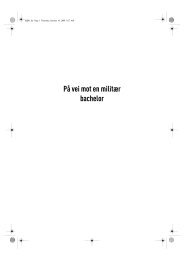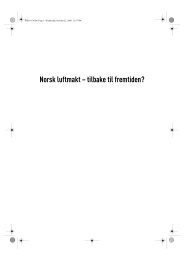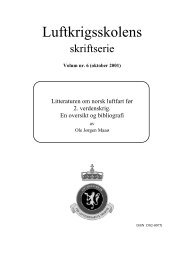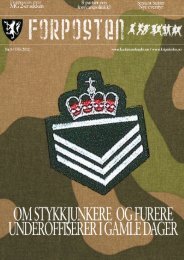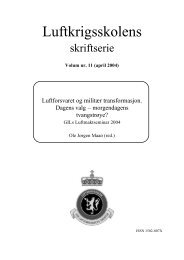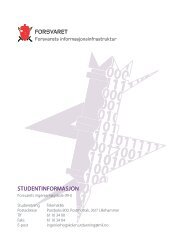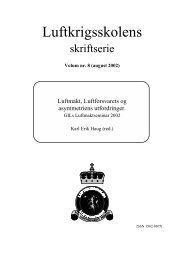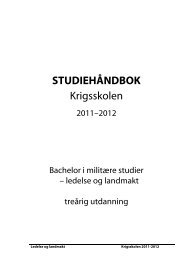Wilhelm Mohr
Wilhelm Mohr
Wilhelm Mohr
Create successful ePaper yourself
Turn your PDF publications into a flip-book with our unique Google optimized e-Paper software.
Reconnaissance Wing at Værnes<br />
Lieutenant <strong>Wilhelm</strong> <strong>Mohr</strong> was Deputy<br />
Commander of the Reconnaissance<br />
Wing of Trøndelag Air Unit at<br />
Værnes. The Wing numbered nine<br />
Fokker aircraft, a model from 1924.<br />
The alert of the German attack sounded<br />
at 03:30 on the morning of 9 April<br />
1940. They knew operations from<br />
Værnes would be impossible, so they<br />
put skis on the airplanes to enable<br />
operations off base, and took off for<br />
Selbu.<br />
<strong>Mohr</strong> leaves for Scotland<br />
<strong>Mohr</strong> left for Scotland from Molde on 2 May<br />
1940, together with Major Øen. The city had<br />
been bombed by the Germans and was burning<br />
when they left. A German bomber attacked them,<br />
and they had to steer the fishing boat zigzag to<br />
the shoreline outside Molde. The boat sank, but<br />
they found another and set course for Scotland.<br />
Reconnaissance Wing at Selbu<br />
When the Wing reached Selbu,<br />
they saw a stream of German aircraft<br />
heading for Værnes. Because<br />
of easy road access between<br />
Stjørdal and Selbu, they knew they<br />
could not stay there, and flew<br />
down to Aursunden.<br />
<strong>Mohr</strong> at Lesja Woods Lake<br />
On 24 April 1940, <strong>Mohr</strong> landed on Lesja Woods Lake<br />
to link up with Major Øen, who had established an<br />
HQ for the remnants of the Air Force at Lesja. <strong>Mohr</strong><br />
landed shortly after the British 263 Sqn. of 18 Gladiators<br />
had been attacked on the lake, of which 13 were<br />
destroyed. Once landed, he spotted three German<br />
Heinkels heading for his Fokker. He jumped out of the<br />
Trondheim <br />
aircraft, only to find himself in deep snow, unable to<br />
move. The Heinkels made three runs, but missed<br />
<strong>Mohr</strong> and the Fokker. He managed to re-enter the aircraft<br />
Molde<br />
Røros<br />
and take it to a more secure location.<br />
NORWAY <br />
<strong>Mohr</strong> meets General Ruge (ChoD)<br />
at Otta<br />
<br />
Tynset<br />
Upon meeting Major Øen, <strong>Mohr</strong> was sent to<br />
the commanding general to seek approval of<br />
<br />
<br />
the plan to leave for the UK to start training<br />
there. He was said to be ‘somewhere in the<br />
Gudbrands Valley’. <strong>Mohr</strong> found General<br />
Ruge on a farm close to Otta, and discussed<br />
the issue for about an hour. Ruge told him<br />
that the British forces would have to be Bergen<br />
withdrawn from South Norway. Overwhelming<br />
German airpower would make<br />
reinforcement and supplies impossible. The<br />
King, the government, and he himself would<br />
shortly leave for North Norway. The plan to<br />
go to the UK was approved. Ruge told <strong>Mohr</strong><br />
that it was important to make ‘identiable Stavanger<br />
Norwegian units’ in the Allied effort to fight<br />
the Germans, as it would be important when<br />
the reckoning after the war was to be made.<br />
0 50 100 Kilometres<br />
Kristiansand<br />
0 50 100 Miles<br />
Figure 1: Map – <strong>Wilhelm</strong> <strong>Mohr</strong>, April 1940.<br />
Reconnaissance<br />
Wing at Aursunden<br />
Because they learned that an<br />
army unit had established<br />
some sort of HQ at Røros,<br />
they flew down to the west<br />
side of Aursund Lake. <strong>Mohr</strong><br />
took command of the Wing<br />
on 13 April 1940 — at 22<br />
years old. They operated<br />
from there until later that<br />
month, performing re-connaissance<br />
missions to map<br />
out the German advances on<br />
the ground. Assessing the<br />
Wing’s operations, <strong>Mohr</strong><br />
himself — in his usual modest<br />
way — said ‘I would not<br />
say it had any signicant<br />
usefulness.’<br />
SWEDEN<br />
<strong>Mohr</strong>’s emergency landing at Fokkstua<br />
By late April, it became clear that South<br />
Norway would have to be surrendered to the<br />
German forces, and it was decided that each<br />
pilot could choose if they wanted to continue<br />
their fight against the Germans in North<br />
Norway, or go to Lesja to start preparing for<br />
the journey over to the UK and continue the<br />
fight from there. <strong>Mohr</strong> chose Lesja. By now,<br />
the Germans had advanced to Tynset. On his<br />
low-level flight towards Lesja from Aursunden,<br />
a german bullet went through the wing<br />
of his Fokker, and petrol started to pour out<br />
of it. He performed an emergency landing<br />
just north of Fokkstua. After fixing the aircraft<br />
and getting fuel by snow-sledge, he set<br />
course for Lesja.<br />
12



